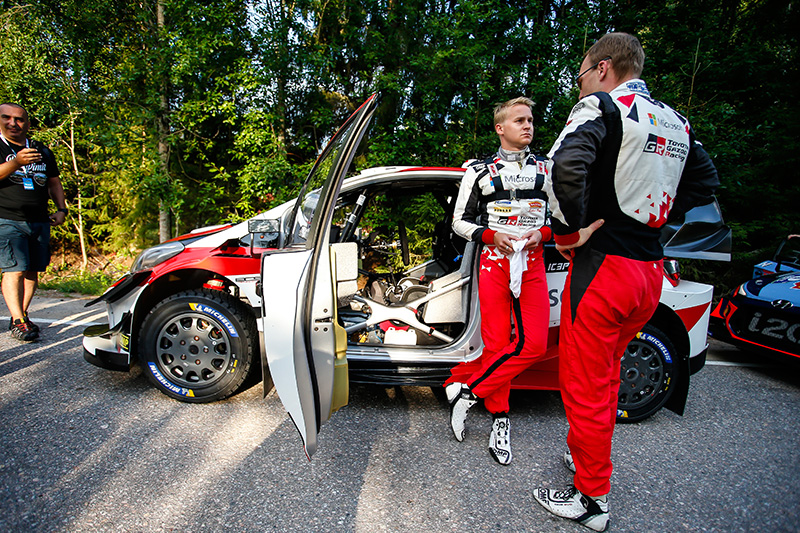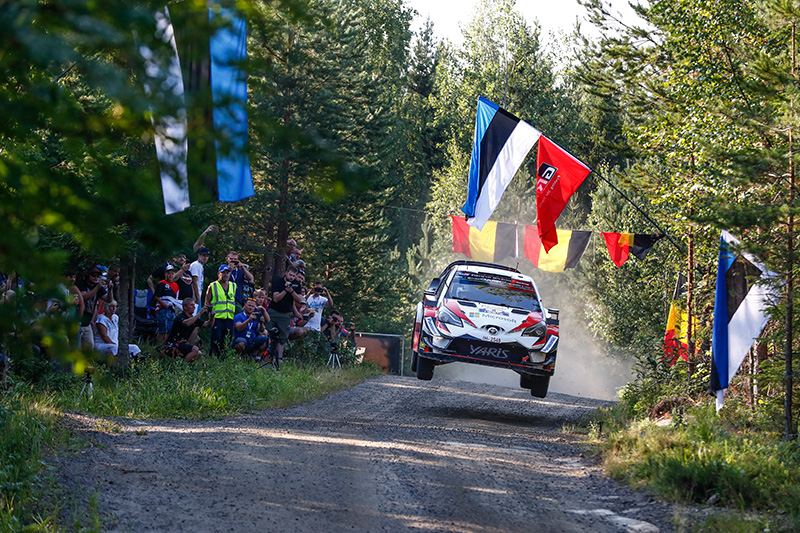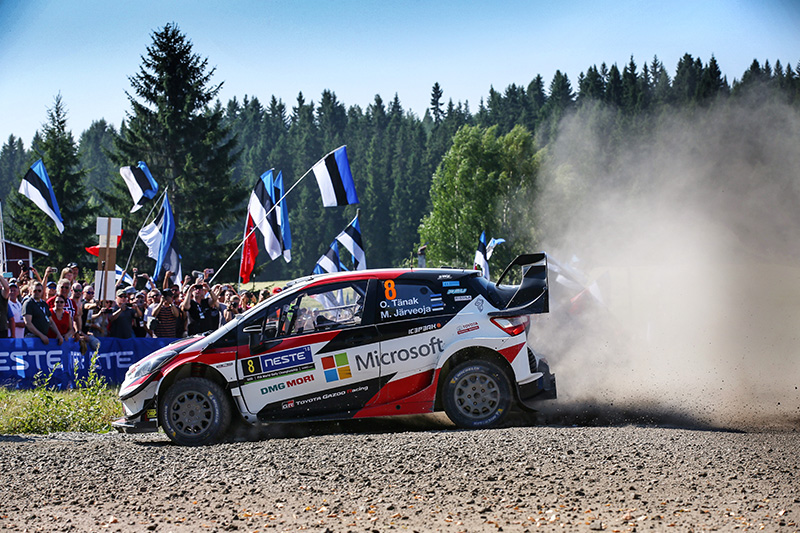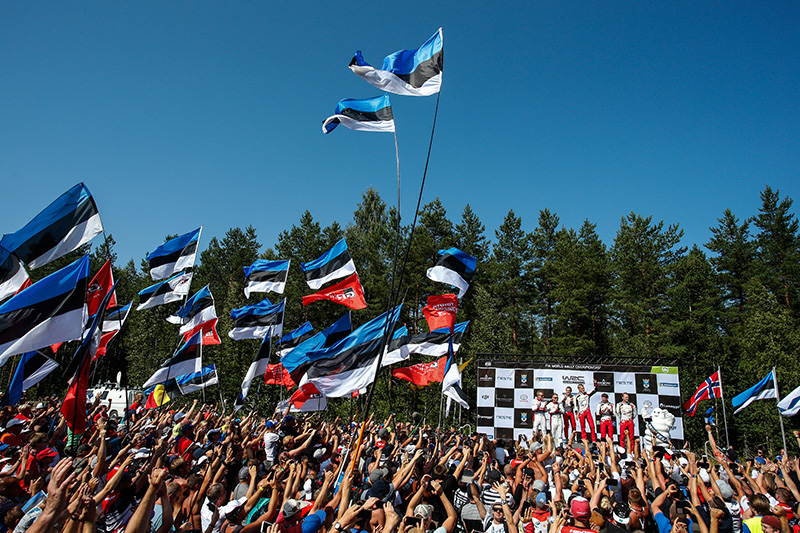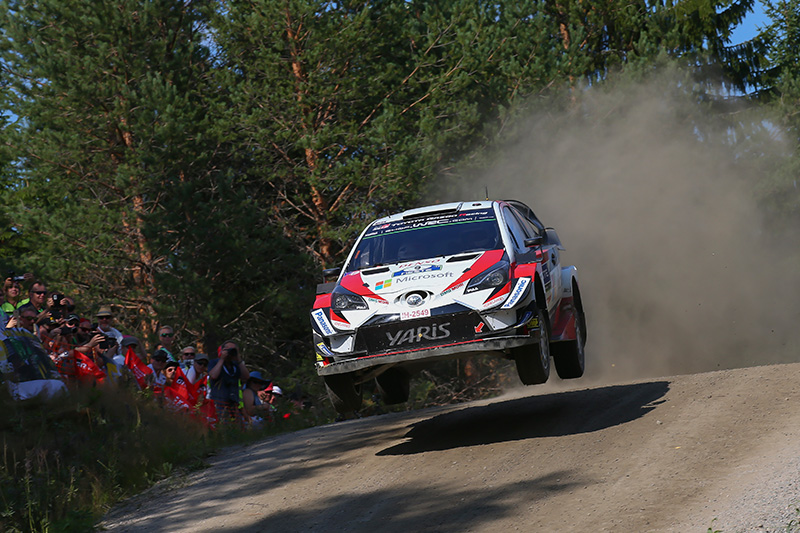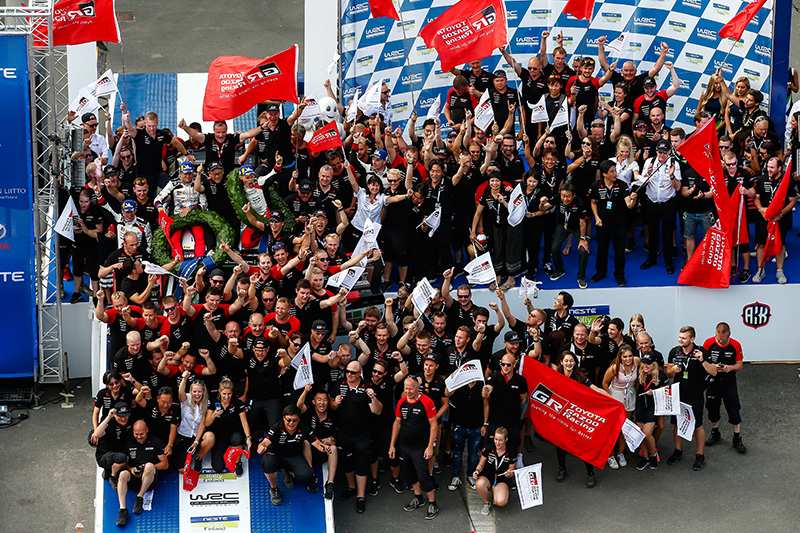RALLY FINLAND
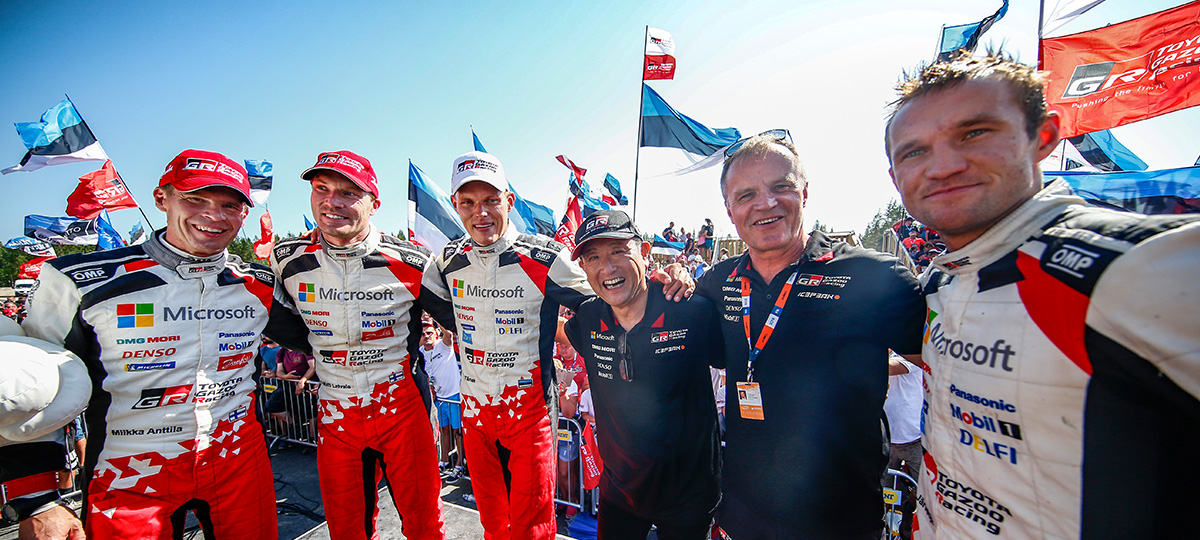
Tänak secures his second victory of the season at one of the WRC’s leading high-speed gravel rallies
Latvala overcomes a long-standing slump to take the final podium spot
Following their recces (an abbreviation of “reconnaissance,” where drivers check out the courses before the start of the rally) of Rally Finland, the majority of drivers were of the opinion that “this year’s stages are different to usual.” Compared to 2017, approximately 65 percent of the entire rally course had been updated; even when the stage names remained the same, some of the route had been altered or the length modified. The hosts’ desire for change was palpable. More broadly speaking, this year’s edition of Rally Finland was characterized by a greater number of twisty sections with narrower average road width.
In Finland, a large number of unpaved gravel roads are used by the population in their everyday lives. The roads are temporarily closed to the general public for the duration of the rally and used as Special Stages. Since they ordinarily see large volumes of traffic, these roads are well looked after—they are comparatively free of gravel and easy to drive. However, a number of narrow roads were added to this year’s course and, since these roads tend to have less traffic, they have a greater preponderance of gravel and the road surface is softer. To compound matters, this summer Finland experienced a succession of fiercely hot days; as a consequence, the gravel was more susceptible to rising to the surface of the bone-dry road surfaces than in previous years. The rally cars had to race across this “loose gravel,” as it is known, where they were more liable to slip and slide. For drivers higher up the starting order, then, the course presented an unusually difficult challenge as they were forced to sweep the sands over the surface.
Before the rally, Ott Tänak was a picture of calm which carries much self-confidence: “Yes, it is true. On this year’s stages, those of us starting earlier may well be at a disadvantage. However, the car itself is in extremely good shape, and I was able to win Rally Estonia—a rally I drove in the Yaris WRC just recently—so my preparations have been excellent. All that is left for me is to drive to the full extent of my abilities.”
Tänak is famed for his expertise in high-speed rallies; in particular, he is regarded as the fastest of the current crop of rally drivers on narrow, high-speed courses where any mistakes are heavily punished. The Estonian came into the rally in third place in the drivers’ championship; he was thus the third driver to start on Day Two, which marked the start of the true gravel stages that run through the Finnish forests. While there was no avoiding the negative impact of the loose gravel, Tänak was confident that if he could find the optimal balance in the Yaris WRC himself, he had the ability to win in any conditions.
Despite the disadvantage of starting third, Tänak displays overwhelming speed to end Day Two on top
Jyväskylä, where the service park was located, hosted the opening stage of Rally Finland. Tänak duly recorded the fastest time of SS1 to finish the first day at the top of the standings. On Day Two, when the rally switched to gravel stages that wound through forests, Tänak was again fastest on SS2. On this approximately 20-kilometer long Special Stage, the two drivers who started ahead of the TOYOTA GAZOO Racing driver were some 15 to 20 seconds slower—this was an indication of just how slippery a surface Tänak had to contend with. On the following stage, SS3, Jari-Matti Latvala in the No.7 Yaris WRC went quickest. Esapekka Lappi, last year’s winner, was delayed due to an issue with the center differential that controlled his drivetrain, but there could be no denying the outstanding performance of the Yaris WRC.
From SS4, however, Mads Østberg, who was 9th in the starting order, showed superb pace to overtake Tänak at the top of the rally standings. In the stages that followed, Tänak and Østberg traded fastest times in a fierce battle for supremacy. Østberg, who was born in Norway, is also known for his proficiency on high-speed gravel rallies, and he drove adeptly on the roads that had been swept clean of loose gravel by the drivers that went before him. But Tänak continued his all-out push and, despite the unrelenting course conditions, he was fastest of all on five of Day Two’s 10 Special Stages. Having finally retaken the rally lead on SS9, Tänak finished Day Two in first place, holding a 5.8-second gap to Østberg in second place. The two drivers, competing for the first place of drivers’ championship, who started the day’s stages earlier than Tänak, made a number of mistakes and ended the day some 2 minutes 59 seconds and 1 minute 58 seconds off the lead. These times revealed just what a handicap it was to start so early; at the same time, they brought into sharp relief the incredible speed displayed by Tänak, who appeared unimpeded by the surface conditions.
Liberated from his role as surface sweeper, Tänak demonstrates his true speed
On Day Three, Tänak was 11th in the starting order on each of the Special Stages, and he was finally freed from his role as “surface cleaner.” The Estonian, who was now able to drive on cleaner roads, demonstrated his true speed: he recorded the fastest time on five stages in succession, from SS12 to SS16. By this point, his advantage over Østberg in second place had grown to 32 seconds. Sensing that this gap was sufficient, Tänak thereafter took things a little easier: “I did my absolute best on Day Two so that I would be given an advantageous position in the starting order on Day Three. On Day Three, I was able to set good times without having to push too hard. Everything is going smoothly.” Indeed, by the end of Day Three, Tänak had stretched his lead over second place to 39 seconds, and victory was all but assured.
Day Four, the final day of the rally, played host to just four Special Stages. Tänak drove the first three of these stages in a controlled manner; if his aim was to guarantee overall victory, then it would have made sense to rein in his aggression on the final Special Stage as well. However, since the final stage was the Power Stage, where drivers with the top five times are awarded bonus points for the drivers’ championship, Tänak was determined to attack: the TOYOTA GAZOO Racing driver again set the best time as he racked up an incredible 12th stage win of the rally. The finish to the stage was engulfed by a sea of Estonian flags, from the homeland of Tänak,TOYOTA GAZOO Racing flags, and a celebratory atmosphere. After crossing the finish line, Tänak parked his Yaris WRC and, together with his co-driver Martin Järveoja, stood atop the roof of the car. The two rally winners were subsequently joined on the Yaris WRC by Team Principal Tommi Mäkinen and Team Chairman Akio Toyoda.
A special victory at the spiritual home of TOYOTA GAZOO Racing WRT
Team Chairman Toyoda, who had his first taste of WRC victory at Rally Finland, spoke of his joy at the team’s performance: “There is no happier feeling than to take victory in Finland—our TOYOTA GAZOO Racing World Rally Team's home. I really appreciate all of our team members for bringing this excitement to us. I really appreciate that I could enjoy this happiness in person and see the view from the top of the podium.”
This was Tänak’s second victory of the season and his first since round five—Rally Argentina. He commented happily with a calm look on his face: “Everything went as well as I had expected—it was a perfect weekend. I am extremely grateful to the team, who provided me with such an incredible car, and to all the fans who came to support us.” Latvala finished in third overall, missing out on second place by just 3.2 seconds. As the two teammates stood on the podium together, Tänak expressed his heartfelt gratitude to all the fans.
In order to secure victory at TOYOTA GAZOO Racing WRT’s home event, Tänak, his fellow drivers, and all the team staff had made careful preparations. Chief Engineer Tom Fowler said after the rally: “The Yaris WRC had already shown ample performance in high-speed rallies. However, we steadily continued to fine-tune the car in order to improve its performance still further. The major point of difference at this rally was the introduction of an updated engine, and I believe this was one of the reasons for our victory.”
Boasting increased torque, the updated TMG engine contributes to victory
Toyota Motorsports GmbH, a German arm of the Toyota Group, is responsible for developing the 1.6-liter inline 4-cylinder direct injection turbo engine. While the engine had performed admirably in previous rallies, the drivers were keen for more torque. Consequently, the development team set to work on an updated engine that, while maintaining the high output of the previous engine, featured both increased maximum torque and increased output at low and medium engine rotation speed zones. This engine was introduced for the first time at Rally Finland. Higher output at low and medium engine rotation speed zones resulted in improved acceleration out of corners, and also made it easier to use the throttle to control the balance of the car while cornering; in other words, the update had a hugely positive impact on the handling performance of the Yaris WRC. Moreover, the increased output at low and medium engine rotation speed zones enabled the drivers to take corners at a one-step higher gear than before; this necessitated fewer gear changes, and power was thereby transmitted to the road surface with minimal loss. Evidently, the evolution of the engine contributed significantly to the team’s victory at Rally Finland.
Despite a second successive victory at Rally Finland, a number of issues remain
However, the team did not have it all its own way at Rally Finland. At the start of Day Two, issues with the center differential impacted negatively on the handling of Lappi’s Yaris WRC, and he lost valuable time. Having won here last year, Lappi was seeking a second consecutive victory in Finland. However, in part due to problems with his car, the Finn had dropped as low as eighth in the overall standings partway through Day Two. Fortunately, the engineers were able to resolve the problem immediately and, having regained his speed, Lappi went on to record two stage wins on Day Two and a further three stage wins on Day Three, as he climbed back up to fourth overall. However, a crash on the first Special Stage of Day Four forced him to retire from the rally. The team’s original goal was to lock out the podium, and it was disappointing that mechanical issues and a crash had denied them the opportunity. Going forwards, two areas for improvement remain: reducing the frequency of mechanicals problems, and ensuring that drivers complete the rallies without incident.
Next up is Rallye Deutschland, a tarmac event. Germany is the home rally for TMG, responsible for engine development. The rally itself is markedly different to Rally Finland, but Tänak was victorious here last year and the Yaris WRC was also extremely competitive on several stages. Team and drivers will unite as they seek to win their third rally—and their first on tarmac—of the season.
RESULT
| Pos | Driver | Co-Driver | Vehicle | Time |
|---|---|---|---|---|
| 1 | Ott Tänak | Martin Järveoja | Toyota Yaris WRC | 2h35m18.1s |
| 2 | Mads Ostberg | Torstein Eriksen | Citroen C3 WRC | +32.7s |
| 3 | Jari-Matti Latvala | Miikka Anttila | Toyota Yaris WRC | +35.5s |
| 4 | Hayden Paddon | Seb Marshall | Hyundai i20 Coupe WRC | +1m35.6s |
| 5 | Sebastien Ogier | Julien Ingrassia | Ford Fiesta WRC | +2m15.0s |
| 6 | Teemu Suninen | Mikko Markkula | Ford Fiesta WRC | +2m19.2s |
| 7 | Elfyn Evans | Daniel Barritt | Ford Fiesta WRC | +2m29.5s |
| 8 | Craig Breen | Scott Martin | Citroen C3 WRC | +3m08.4s |
| 9 | Thierry Neuville | Nicolas Gilsoul | Hyundai i20 Coupe WRC | +3m51.8s |
| 10 | Andreas Mikkelsen | Anders Jaeger | Hyundai i20 Coupe WRC | +8m37.4s |
| Retired | Esapekka Lappi | Janne Ferm | Toyota Yaris WRC |

